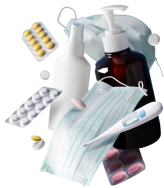Healthwire Pharmacy provides 100% genuine medicines straight to your doorstep.
Order Now! & Avail
Upto 10% OFF On All Your Pharmacy Orders!
Empagliflozin 10mg
Healthwire Pharmacy Ratings & Reviews (1500+)
Product Information
Empagliflozin is a medication used to treat patients with type 2 diabetes mellitus. It is typically administered as a tablet taken once a day, with or without food. These tablets inhibit the enzyme sodium-glucose cotransporter-2, which ultimately reduces blood sugar levels within the body. Alongside its glucose-inhibiting properties, empagliflozin also promotes weight loss and prevents cardiovascular disease. By reducing glucose absorption and encouraging the excretion of excess sodium and water, the drug decreases body weight. In terms of cardiovascular disease prevention, the medication improves cholesterol levels and reduces the risk of heart-related complications in those with type 2 diabetes.It is important to follow medical advice and guidelines when taking empagliflozin. Consultation with a licensed medical practitioner is necessary to ensure the regime aligns with individual health needs. This information is a simplified version and should not replace professional medical advice.
Empagliflozin 10mg
Sodium-Glucose Co-Transporter (Sglt-2)
Tablet
Empagliflozin is utilized for the following therapeutic indications:
Tailoring Treatment for Optimal Health, Prescribed Medication Dosage is:
An Empagliflozin 10mg overdose requires immediate medical attention. The specific treatment approach depends on the individual patient and their particular clinical situation. Though below is a compilation of general treatments for an Empagliflozin overdose.Empagliflozin is a drug that can help restore low blood glucose levels and reduce the risk of further low blood glucose problems. It is usually used to treat adults with type-2 diabetes mellitus who are overweight or have obesity and face challenges in controlling their blood sugar levels. In specific cases of an overdose, clinicians may use Empagliflozin in higher doses as a means of treatment.An Empagliflozin overdose could result in low blood glucose (hypoglycemia) or adverse effects on the kidneys (renal impairment). So, it is vital to monitor vital signs and assess cardiac and renal function. Medical providers must take appropriate measures to correct low blood glucose levels as part of a comprehensive medical response.
Maintaining a regular schedule for taking medications like Empagliflozin 10mg is important to ensure its effectiveness. If you forget to take a dose, you should take it as soon as you remember. However, if it is almost time for the next scheduled dose, it is recommended to skip the missed dose and continue with your regular schedule. Do not double up on the next dose to make up for the missed one, as it can lead to an overdose or adverse effects. It is always a good idea to consult a doctor if you have any further questions or concerns about missing a dose, as they can provide you with advice specific to your condition and medication.
Take empagliflozin 10mg at the same time every day as prescribed, and ensure you swallow the tablet whole with water. It is okay to take this medication with or without food. However, to maintain its effectiveness, it is recommended you take it around the same time daily. Make sure to keep this medication away from the reach of children and pets. Moreover, it is important to consult your doctor or pharmacist before using this medication, in case you are faced with any questions or concerns. Your doctor will explain dosage and duration of treatment depending on your condition and body's response to the medication. It is important to not take more or less of a dose, or take the medication more often than prescribed by your healthcare provider.
Discerning instances where this medication may not be appropriate:
Unraveling the side effects lurking behind this medications are as follows:
Empagliflozin 10mg is a prescription medication employed to treat adults with type 2 diabetes mellitus. This medication should be stored in a safe location, away from the reach of children and pets. Ensure that the storage area remains cool and dry, at approximately 25°C or less. It is important to keep Empagliflozin 10mg in its original container at all times, ensuring the medication is never removed from its pill bottle. To ensure the maximum safety and effectiveness of the medication, tablets should not be split unless a scoreline is present and a medical professional has advised otherwise. Should you have any questions or concerns about the storage of Empagliflozin 10mg, or require further information regarding important safety measures, please consult with your doctor or pharmacist. They will gladly provide guidance on proper storage conditions and other pertinent details regarding this medication.
Empagliflozin is a prescription drug intended for individuals with type 2 diabetes. It works by helping your kidneys get rid of any excess blood sugar, thereby reducing your blood sugar levels. While the efficacy of this medication is well documented, there are some common side effects worthy of note. To start, patients taking Empagliflozin may experience some issues with their kidneys, so doctors will often order lab tests to monitor kidney health. These tests include checking for serum creatinine levels and the estimated glomerular filtration rate (eGFR). Secondly, since weight changes can impact blood sugar levels, it is also typical for doctors to monitor a patient's weight and Body Mass Index (BMI) when taking Empagliflozin, just to be sure this medication is not causing unintended side effects such as excessive weight loss or weight gain. Additionally, this drug can also have an effect on cholesterol levels, so regular cholesterol tests are ordered to ensure cholesterol levels stay within a healthy range. Because this medication can cause elevated potassium levels in the blood, regular monitoring of potassium, sodium and bicarbonate levels is recommended, to ensure these levels stay stable. Blood pressure is also commonly monitored while taking Empagliflozin, as this drug can cause low blood pressure, known as hypotension. Finally, it is important to note that your doctor will determine how often these tests should be conducted, and necessary adjustments to dosage and medication will be made based on the results of these tests and a full understanding of your individual needs and drug responses. Therefore, it is important to notify your doctor about all medications and supplements you're taking, even if they're over-the-counter or natural remedies.

Order Now! & Avail
Upto 10% OFF On All Your Pharmacy Orders!

If you face any issue, feel free to contact us. We provide 24/7 support to assist your problems